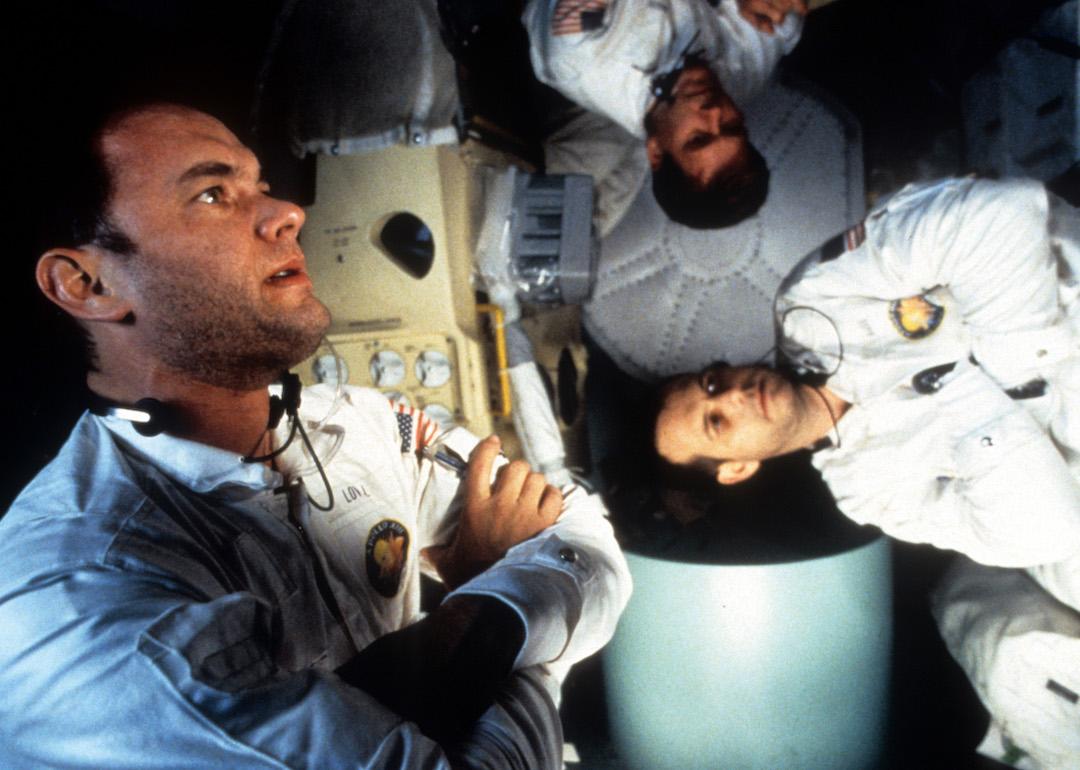
From 'Spacewar!' to 'Starfield': A history of video gaming
This story originally appeared on Gamesville and was produced and distributed in partnership with Stacker Studio.
From 'Spacewar!' to 'Starfield': A history of video gaming
While the medium of video games is relatively nascent compared to film and television, the global industry of interactive entertainment is projected to be valued at $307 billion by 2029. Video game properties have permeated mainstream popular culture, with characters like Mario and Sonic the Hedgehog achieving the same recognition as Mickey Mouse, and "The Last of Us" becoming the first video game adapted into an Emmy-nominated show.
Of course, this level of success took decades of build-up. What is now a major pillar in the entertainment world started as mere projects to tinker with in the early days of computing. To track the history of video games, Gamesville dove into the research labs and dusty arcades where games like "Spacewar!" and "Pac-Man" got their start to piece together the history of gaming—and how technology continues to advance the medium today.
The 1960s: The video game is born
One can pinpoint the origins of video gaming to the Massachusetts Institute of Technology, where Steve Russell and a team of fellow students set out to create a program for the university's new PDP-1 computer.
Inspired by sci-fi fiction and the real-life Space Race in 1961, Russell and his friends created "Spacewar!," a competitive experience that pitted two user-controlled spaceships against each other. "Spacewar!" became a phenomenon on the MIT campus and soon spread to other universities with computer science programs. Although it wasn't a commercial product, many consider "Spacewar!" the first accessible and widely played video game.
The 1970s: The arcade boom
In the following decade, arcade machines and home video game consoles emerged, forever changing American culture and consumerism. In 1972, electronics company Magnavox sold the Magnavox Odyssey home console, which allowed owners to play simple games on their television sets for the first time.
A popular game that users could play on the Odyssey was a table tennis game. Not long after viewing a demonstration in 1972, electrical engineer Nolan Bushnell, who had played "Spacewar!" as a student, co-founded Atari, which put out its own tennis game called "Pong." It was one of the first arcade video games housed in a dedicated coin-operated cabinet.
"Pong" was one of the early commercially successful video games—other hits that followed in the '70s arcade boom included Atari's "Breakout" (co-designed by future Apple co-founder Steve Wozniak) and "Asteroids," and the Japanese-developed "Space Invaders."
The 1980s: The Nintendo revolution
While the arcade boom continued in the '80s with titles like "Missile Command," "Pac-Man," and "Galaga," home video gaming was becoming increasingly popular. Atari struggled financially with its home consoles, with a botched Atari 2600 port of "Pac-Man" in 1982 and a poor adaptation of "E.T. the Extra-Terrestrial" often cited for the company's misfortunes and loss of consumer confidence.
A toy company from Japan swooped in to help the industry rebound. Nintendo began to lead the market with its Nintendo Entertainment System home console (known as the Famicom in Japan) in the middle of the decade. "Super Mario Bros.," a home console follow-up to Nintendo's "Donkey Kong" and "Mario Bros." arcade games, became a commercial and cultural force with its precise controls, memorable visuals, and catchy music.
Nintendo and rival Japanese company Sega found success after the downfall of American console manufacturers like Atari—and it would continue to dominate the home console market for years to come.
The 1990s: Gaming goes 3D
As computers became more accessible in the '90s, so did many types of video games. Titles including "Wolfenstein 3D" and "Doom" by id Software became highly influential 3D first-person shooter games available through CD-ROM.
In the home console market, Nintendo was met with new competition from Sony, which entered the business after an infamously failed proposed partnership with Nintendo. When the Sony PlayStation launched in 1994, it made a dent in the Super Nintendo and Sega Saturn consoles, kicking off a new era of 3D graphics-capable machines.
Nintendo continued to lead the industry creatively, debuting its Nintendo 64 console two years later that came with hugely popular games like "Super Mario 64," "The Legend of Zelda: Ocarina of Time," and the couch multiplayer phenomenon "GoldenEye 007."
At the same time, PlayStation dazzled consumers with "Final Fantasy VII" (a steal from Nintendo), "Crash Bandicoot," and "Tomb Raider," among other titles, which all took advantage of PlayStation's native CD-ROM support—the Nintendo 64 was still using cartridges for its games. By the end of the '90s, arcades were taking a backseat to home consoles and computer gaming, and handheld devices like Nintendo's Game Boy were also coming into style.
The 2000s: The age of the blockbuster
Sega's stronghold on the home console market started to falter by the turn of the century, culminating in the discontinuation of the Dreamcast console in 2001. At the same time, American software company Microsoft made a big bet in entering the competition with the Xbox that same year. Between 2000 and 2001, Sony's PlayStation 2, Microsoft's Xbox, and the Nintendo GameCube solidified themselves as the big three of the industry, with the PlayStation 2 being the bestselling video game console of all time to this day.
The industry continued to push the boundaries of home video gaming throughout the decade. In 2006, Nintendo launched the Wii, one of the first home consoles to utilize motion controls. It brought an appeal to casual and nongaming audiences alike.
Wii Sports, which allowed players to compete in golf, boxing, tennis, baseball, and bowling, had fans of all experience levels and ages; it's still the console's bestselling game to date.
By the mid-2000s, individual video game launches were becoming akin to big movie premieres. The 2007 launch of Microsoft's "Halo 3," an anticipated sequel, was the biggest entertainment launch in history. The estimated $170 million in sales exceeded contemporaries at the time, like the debut weekend of "Spider-Man 3" and the launch of "Harry Potter and the Deathly Hallows."
The 2010s: The gaming world gets smaller and goes virtual
By the 2010s, high-definition displays and graphics were the norm in video games, as were online multiplayer and mobile phone gaming. As the technology became more complex, so did the narratives and presentations for games.
Thanks to motion capture technology and the efforts of artists and writers, video games like "The Last of Us" (2013) and "Red Dead Redemption 2" (2018) impressed even those outside of traditional gaming audiences. Rockstar Games' "L.A. Noire" even had a chance to demonstrate its advanced facial capture at the Tribeca Film Festival in 2011.
Virtual reality began formulating and continued to mature through the decade, most prominently through the efforts of Oculus with its Rift headset that debuted in 2012. Augmented reality games like "Pokémon Go" also made headlines in 2016, and Nintendo, which struggled with its Wii U console in 2012, made a comeback with the Nintendo Switch in 2017. The console, one of the first of its kind, allowed users to move between playing games on their handheld device and their television console.
Today: Taking things to the cloud and metaverses
Online video game streamers are prevalent on platforms including YouTube and Twitch. Some of the biggest games, such as "Fortnite" and "Overwatch," are free to play—though microtransactions are common for these popular titles. Microsoft, Amazon, and at one point, Google have provided options to game on computers, mobile devices, and televisions without the need for any hardware.
Corporate consolidations have also defined the early 2020s, starting with Microsoft acquiring Bethesda, which is behind popular franchises like "The Elder Scrolls," "Fallout," and "Doom." Bethesda's upcoming space-themed RPG "Starfield" is one of the most-anticipated titles of 2023.
Sony has also purchased a number of game companies, most prominently "Destiny" developer Bungie. As of July 2023, Microsoft is in mid-acquisition of "Call of Duty" and "Overwatch" owner Activision Blizzard, a highly scrutinized proposed takeover.
Six decades after "Spacewar!" came to fruition, the video game industry has grown far beyond a college project. As technology continues to evolve, the medium is sure not only to adapt, but also pioneer uses that transport players into worlds even those MIT students couldn't have imagined.
Story editing Jaimie Etkin. Copy editing by Kristen Wegrzyn.



